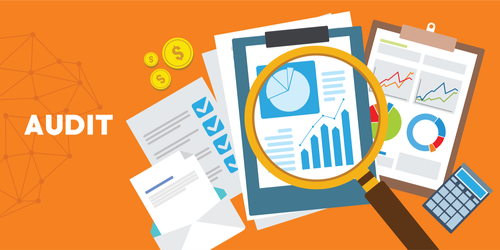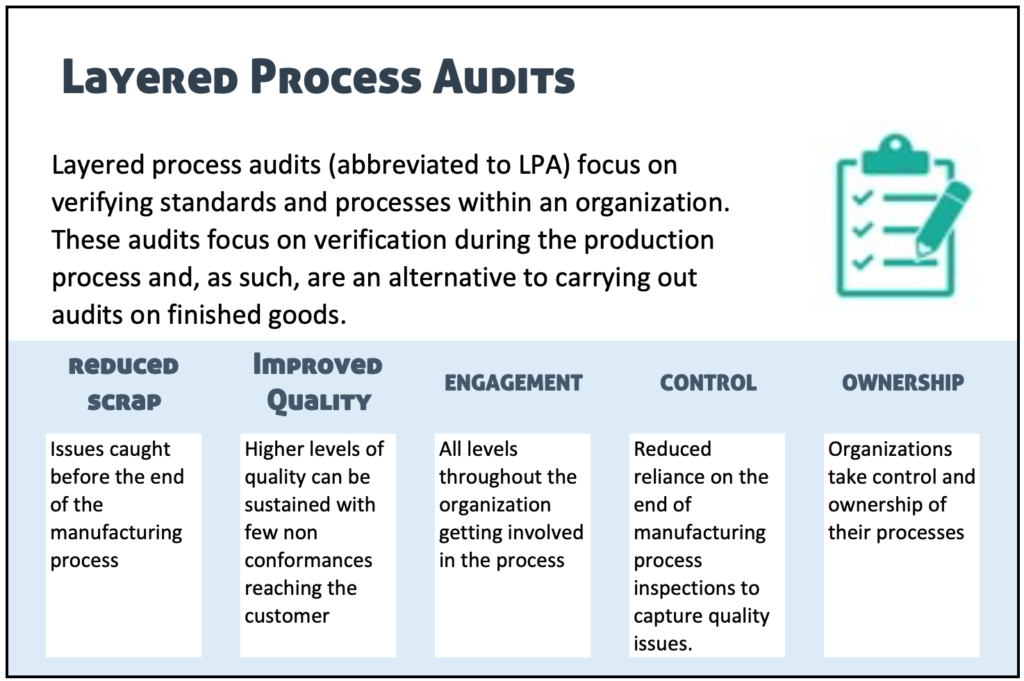
Layered process audits (abbreviated to LPA) focus on verifying standards and processes within an organization. These audits focus on verification during the production process and, as such, are an alternative to carrying out audits on finished goods. They have several attributes that include:
- They occur regularly
- They often occur at high volume (especially where there is a risk of non-conformance)
- They are administered by all levels of an organization
- While originating in Automotive, they can now be found in many industries
In today’s article, we’ll be exploring Layered Process Audits; we’ll be covering.
- What is a Layered Process Audit
- Where are layered process audits used
- Who carries out layered process audits
- Why use layered process audits
- How to make layered process audits effective
- Issues with Layered Process Audits
- Benefits of Layered Process Audits
What is a Layered Process Audit
As we all know, audits and inspections are commonplace in industry. They help verify products and stop non-conformances from reaching the customer.
As we described in our introduction, Layered Process audits are an alternative method to end of manufacture product audits.
Think of a Layered Process Audit as scrutinising how a product is made and validating against processes and policies. As a manufacturing process is likely to consist of many steps, the frequency of these audits is high.
When implemented correctly is a highly effective method of ensuring:
- Processes are followed consistently
- Methods and processes align with standards
- Error proofing steps in the process are effective
The result of this is
- Scrap and rework are reduced (because it is caught before the end of the manufacturing process).
- Quality is improved
- All levels of the organization are engaged in quality, and it becomes a prime focus of the business.
- There is a reduced reliance on the end of manufacturing process inspections to capture quality issues.
- Organizations take control and ownership of their processes (which includes methods, measurement, equipment and importantly, people)
- Safety is improved
As layered process audits happen while the process is running, issues such as defects and non-conformance are captured “live” and importantly before the stage is completed allowing for corrective action to take place, in situ.

This is a powerful attribute as it helps in several areas such as
- Reducing scrap
- Reducing non-conformance of the end product
- Helping to minimise the need for inspection at the end of the manufacture/production process (as things are reviewed along the way.)
- Capturing issues that are unlikely to be caught on final inspection but may affect the customer (i.e. durability).
Consider your own processes for a moment and the impact of only utilizing end of manufacture audits. You will no doubt catch some non-conformances, but by this stage it is usually too late and you are likely to be faced with:
- Significant costs to rectify the situation
- Impact on your customer.
LPA’s help to mitigate these issues.
They have several characteristics, which include:
- Simple audit processes, for example, usage of short checklists that guide the auditor through the process
- Audits are usually focused and of short duration
- Use of questionnaires which facilitate auditors with little knowledge of the process
- Extensive use of different layers of the organization who participate in the process
LPA’s rely on a series of critical enablers:
- Simplification of the audit process (this can include software to help manage the process)
- A focus on processes where deviations might occur and non-conformance is highly likely
- Not relying on specialist expertise or knowledge (see simplification of audit process)
- Effective containment processes, once non-conformances are found, to deal with the situation.
- Organizational involvement from all layers.
Where are layered process audits used
While layered process audits found their origins in Automotive, the use is now widespread.
These days they can be found in many manufacturing industries, from Aerospace to Pharmaceutical.
Their usage has increased in industries where critical steps in the manufacturing process need to be monitored closely to avoid nonconformance.
Who carries out layered process audits
While traditional audits and end of manufacture inspections are often confined to being executed by the quality department, Layered Process audits are not.
All employees can be engaged in the auditing process. This includes those participating in the processes themselves and those in a supervisory role through to senior management.
A typical profile might see:
- Operators auditing at the highest frequency
- Line managers carrying out audits at high to moderate frequency
- Senior management carrying out audits over a broad range of processes and tasks at less frequency than line managers.
All audits will include a level of CAPA (corrective action, preventative action) which can take place in situ during the process or afterwards.
The important thing to recognize is that one of the specific targets of this method is engagement by the whole organization.
For layered process audits to be effective, engagement is a must. Success rates will increase as more of the organization participates.
LPA’s are typically co-ordinated/managed via the Quality function.
Why use layered process audits
Non-conformances occur because of a failure to follow standards and processes.
Layered process audits, by their nature, occur in situ within the process and help validate the standards and processes are being followed as manufacture occurs.
As LPA’s focus on how products are manufactured, they are able to find and irradicate non-conforming processes at a much earlier stage than traditional audits.
How to make layered process audits effective
We’ve already talked about key enablers, including:
- Engagement & participation
- Simplification of the audit process
I’d like to make two further recommendations:
1/ Ensure your LPA focuses on the goal of resolving the cause of non-conformance
Successful LPA find problems before they get to the customer, but that is not their primary objective. Their primary objective MUST be to remove the cause for the non-conformance.
Alas, this is often overlooked. To be clear, the goal of the audit is to find and irradicate the cause of non-conformance, not merely the non-conformance itself.
As with any audit system, it has to be a closed-loop, i.e. where problems are found, an action plan is put in place to resolve (i.e. remove) the cause, and actions are followed up to ensure closure.
Stating the obvious, if you find a non-conformance but do not contain the cause, then that non-conformance will happen again and again.
2/ Simplicity wins
For LPA’s to be truly effective, they must be simple. How simple? Well, simple enough that anyone can carry them out.
Remember that not everyone can have specialist knowledge. If your audits require that, then they are unlikely to be successful.
Issues with Layered Process Audits
Here are some common issues with deploying the process that you might want to watch out for:
- Audit process/documentation is not amended/updated as processes change.
- General failure to follow up issues found
- Poor engagement within the organization (often demonstrated by deteriorating participation).
- Audits are overly complicated, meaning participation is hampered.
Benefits of Layered Process Audits
Despite these issues, there is a multitude of benefits:
- All levels of the organization take control of processes
- Reduce risk of non-conformances being delivered to the customer.
- Finds non-conformances earlier than traditional audits
- It helps increase quality at all stages of the process
- Improves chances of timely fixes to processes
Summary
Layered process audits are an essential tool to improve quality.
They can take the audit process and place its focus within an additive manufacturing process. This allows the organization to focus on individual process steps and monitor for non-conformance, capturing quality issues far earlier than traditional auditing. This reduces waste and impacts to the customer.
Do you have experience using LPA’s in your business? Have tips or lessons learned you’d like to share?
As ever, we’d love to hear from you, and you can reach us on Twitter or via the comments section below.
